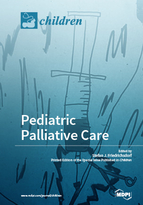Pediatric Palliative Care
A special issue of Children (ISSN 2227-9067).
Deadline for manuscript submissions: closed (30 November 2017) | Viewed by 168976
Special Issue Editor
2. Department of Pain Medicine, Palliative Care and Integrative Medicine, Children’s Minnesota, Minneapolis, MN 55404, USA
Interests: pain medicine; palliative care; integrative medicine
Special Issue Information
Dear Colleagues,
At least 20 million children worldwide would benefit from Pediatric Palliative Care (PPC) annually, and eight million children would need specialized PPC services. In the USA alone, more than 42,000 children, 0–19 years, die annually; fifty-five percent of them are infants younger than one year old. Interdisciplinary PPC is about matching treatment to patient goals and is considered specialized medical care for children with a serious illness. It is focused on relieving pain, distressing symptoms, and stress from a serious illness and is appropriate at any age and at any stage, together with curative treatment. The primary goal is to improve the quality of life both for the child and for his/her family.
Sadly, advances in the control of symptoms in children dying of life-limiting diseases have often not kept pace with treatment directed at curing the underlying disease. Data reveal that the majority of distressing symptoms in children with an advanced serious illness (such as pain, dyspnea and nausea/vomiting) are not treated, and, when treated, therapy is commonly ineffective. Emerging evidence shows that palliative care involvement results in improved quality of life, as well as prolongation of life.
High-quality pediatric palliative care for children with serious illnesses is now an expected standard of medicine. However, there still remain significant barriers to achieving optimal care, related to lack of formal education, reimbursement issues, the emotional impact of caring for a dying child, and most importantly, the lack of interdisciplinary PPC teams with sufficient staffing.
Fortunately, considerable advances have been made in recent years providing PPC around the globe both in resource-poor and resource-rich countries through care provided at children’s hospitals, outpatient palliative care clinics, palliative home care, and free-standing children’s hospice houses. This Special Issue, “Pediatric Palliative Care”, is dedicated to describing existing gaps, as well as the achievements made in clinical care, education, training, and research. Both reviews and original research will be considered for publication.
I am looking forward to receiving your contributions.
Kind regards,
Dr. Stefan J. Friedrichsdorf
Guest Editor
Manuscript Submission Information
Manuscripts should be submitted online at www.mdpi.com by registering and logging in to this website. Once you are registered, click here to go to the submission form. Manuscripts can be submitted until the deadline. All submissions that pass pre-check are peer-reviewed. Accepted papers will be published continuously in the journal (as soon as accepted) and will be listed together on the special issue website. Research articles, review articles as well as short communications are invited. For planned papers, a title and short abstract (about 100 words) can be sent to the Editorial Office for announcement on this website.
Submitted manuscripts should not have been published previously, nor be under consideration for publication elsewhere (except conference proceedings papers). All manuscripts are thoroughly refereed through a single-blind peer-review process. A guide for authors and other relevant information for submission of manuscripts is available on the Instructions for Authors page. Children is an international peer-reviewed open access monthly journal published by MDPI.
Please visit the Instructions for Authors page before submitting a manuscript. The Article Processing Charge (APC) for publication in this open access journal is 2400 CHF (Swiss Francs). Submitted papers should be well formatted and use good English. Authors may use MDPI's English editing service prior to publication or during author revisions.
Keywords
- Pediatric Palliative Care
- quality of life
- symptom management
- hospice







